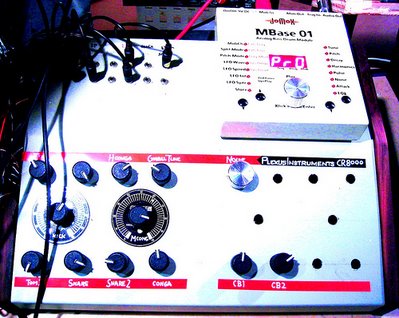Tuesday, January 02, 2007
Man From Uranus at Interzone part three
Jen SX1000 and theremin.
YouTube via manfromuranus. Via sendling. Title link takes you to the rest on sendling.
ITOX Expanding Dragon PCI Host
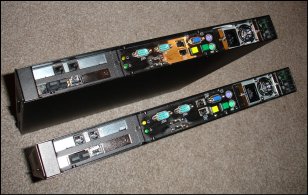 Need a host for that Korg OASYS PCI card? Title link takes you there.
Need a host for that Korg OASYS PCI card? Title link takes you there."Enter the >>ITOX Expanding Dragon, a 1U rackmount PC with full-length PCI slots, available until recently on eBay for $100 a pop. The boxes apparently work fine as OasysPCI hosts (under Windows 98SE, naturally); the only problem with them is that, being designed as servers, they have multiple noisy fans. Other folks on the OasysPCI list (notably Scott Harris) have made progress with alternative power supplies and utilities to control fan speed."
New Zebra 2 Filter Module Sample
 Title link takes you to a sample of a new Zebra 2 Filter module posted by creator Urs Heckmann on this BigBlueLounge thread. I decided to go with the R2 image in the thread as there are no screens yet, and the reference below.
Title link takes you to a sample of a new Zebra 2 Filter module posted by creator Urs Heckmann on this BigBlueLounge thread. I decided to go with the R2 image in the thread as there are no screens yet, and the reference below.Some notes via Urs in the thread:
"Last year I had coincidentally discovered a way to create a filter with a really good sounding self-oscillation when a new scientific paper on Moog filter simulation came up. Latter was a great source of information, but it would still not work like I wanted, especially in terms of cpu hunger and tuning.
So I spent the holidays on getting a Moog Little Phatty and tweaking the shit out of the new filter (dubbed XMF for Croos Modulation Filter). Yesterday it came to the point where
- cpu usage is moderate (2-3% for stereo operation on an 1.83 GHz MBP @44.1 kHz)
- self-oscillation (with no input) is in almost perfect tune and nearly constant level from 50Hz to 14+kHz
- any trick used in Littly Phatty presets would work on the XMF as well
- parameter ranges exceed that of the LP
- bandpass mode works (I gave up on highpass for now)
It's not a perfect emulation of the Moog ladder filter though. But it has all of the properties of an anlogue filter, starting from the juicyness up to the self oscillation that does *not* lock into the spectrum of the incoming signal. Latter is especially interesting. There is a range of resonance where the self oscillation would "wobble" between the actual filter frequency and the closest frequency in the spectrum of the input signal. I havn't heard this in digital filters so far but it's exactly how the Moog does it.
The R2-D2 solo at the end btw. is just the filter with full resonance and a little overload. ModWheel controls filter fm by an oscillator while PitchWheel controls cutoff over several octaves.
The first solo sound (thin, voicy) features filter fm with an oscillator tuned 4 octaves up. Sounds exactly like the LP, with the difference that it's stable & in tune over the whole keyboard range.
The ultra phat guitarish solo sound is not based on hard synced oscillators, it just plain detuned sawtooths run through the bandpass mode with lots of overload.
The pad sound is a couple of detuned sawtooth/pwm oscs run through the bandpass. An lfo modulates the frequency of the bandpass in opposite polarity for right/left side which creates the panning effect.
I think it's almost ready for release, but the SSE code has yet to be rewritten in AltiVec for G4/G5 (no big deal). I'm afraid though that it will probably not work on a G3, or it would consume close to 20% on a G3 when operating mono instead of stereo... and it's gotta be fine tuned & tested for samplerates other than 44.1 kHz...
Later,
Wink Urs"
Previous posts on Zebra 2
Update via Bee Jay in the comments:
Pic for you if you want: [link]
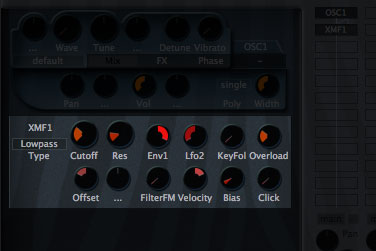
"This is one of the phattest filters I've heard since impOscar - and the bandpass mode is also superb."
Kawai K3m Filter Bank Mod
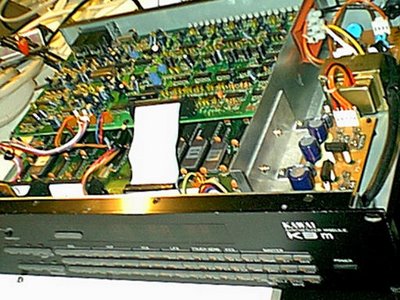 Title link takes you to more info, shots and instructions.
Title link takes you to more info, shots and instructions."Most of my synthesizers are boring DSP-based digital stuff that cannot be easily tampered with. However, one piece in my setup is at least partly analogue: the Kawai K3m. It has 6 voices, each with a dual DCO, a VCF and a VCA. It's rather obvious what part of the synthesizer is plain boring and what could actually be fun to abuse.
Since the K3m is controlled by a microprocessor (which, by definition, therefore is rather boring to mess around with) I saw no point in trying to make the K3m into a 6-channel LP-filterbank (since that would mean having to alter the software), but instead decided to turn it into a 1-channel 6-peak LP-filterbank."
This one via synth ollie, who's friend martin has done this mod.
EMT 250 and 251 Digital Reverb
 Two shots pulled via this PSW Recording Forum thread. Title link takes you to one more.
Two shots pulled via this PSW Recording Forum thread. Title link takes you to one more. Via David Kulka on the thread:
"Maybe I missed it, but has no one mentioned the EMT 250 or 251 on this thread??? Most old timers will remember these but for you young lads, this was one of the first digital reverbs. As you might imagine, the 250 caused quite a stir when introduced in 1976 for a mere $20,000. Plus freight.
A while back we had three of these in the shop -- an obvious photo opportunity -- so Greg took some high res digital shots. The unit on the left is the original 250, the two on the right are 251's. Forum member J.J. ended up buying the one with the big wheels.
There's an article on my website with much more info about these, for anyone who's interested.
Maybe we should do an other worldly-gear calendar? No rude comments boys, this is my WIFE! [Cute comment and image]
Lastly, here's some of the the insides of one -- I think this was the 250. EMT scraped the identification off of all the important IC's so the designs couldn't be copied, which makes servicing them a lot of fun. I finally got a set of the original 250 blueprints from Gotham so I know the secrets of that one now, but I'm still looking for the top-secret info on the 251.
Barry Blesser (past AES president and former Lexicon engineer) was part of the original design team. Here's an archived AES recording in which Barry makes some prescient comments about the industry and talks a little about the EMT project..."

ZO Wins EM 2007 Editors Choice
 Looks like the Cyndustries Zero Oscillator picked up an EM 2007 Editors Choice.
Looks like the Cyndustries Zero Oscillator picked up an EM 2007 Editors Choice.Congrats Cynthia!
Prvious posts:
Cynthia
Cyndustries
Yamaha EX2
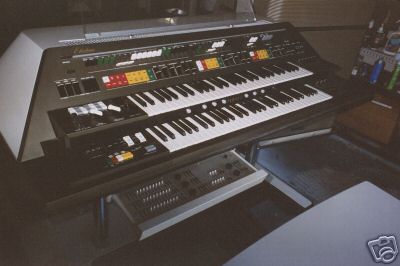 Looks like there is a Yamaha EX2 up on the bay. Title link takes you to shots pulled from this auction.
Looks like there is a Yamaha EX2 up on the bay. Title link takes you to shots pulled from this auction.Note there is also one for sale here, with a price tag of $5995. Details from that listing (not from the Ebay auction):
"(Leslie 122 compatible) This is actually an analog synthesizer cleverly posing as an electronic organ! It was an outgrowth of Stevie Wonder's "Dream Machine" synth, which was used to score the documentary film, "The Secret Life of Plants." This Instrument was owned and operated by the late organist/keyboardist, John Seng, who was both a Yamaha Artist and consultant to that firm in the development of the Dream Machine. Its tonal resources are based on Yamaha's PASS technology, also found in the famous CS-80 synthesizer. What makes this instrument unique is that it's individual sounds were "tweaked" and re-scaled by Yamaha techs to Mr. Seng's personal specs, producing a sound unlike any other production examples of this model. The 1969 Leslie will be included with this Organ (including customized interface) and is in perfect working order. See bottom of page for Leslie photos."
Some previous Yamaha Electone posts
Novation BassStation Rack - MIDI to CV and CV to MIDI Convertor
 No title link, Just an awesome tip from Brian Comnes:
No title link, Just an awesome tip from Brian Comnes:"I was re-working my rack this weekend and I looked at the back side of my Novation BassStation Rack (haven't looke back there for 2 years) and I noticed MID/CV ports on the back so I got out the manual and sure as shit this thing is a switch hitter, it goes MIDI to CV and CV to MIDI and it supports HZ/Volt and Volt/Oct to boot
given that these things can be had for $100 or so on eBay , they are a bargain if you consider that you also get a 2 osc monosynth in the package"
Note this does not apply to the Novation BassStation keyboard.
Update via Bill in the comments:
"You can do this with a Pulse Plus as well. I think they go for about 250$ + you get real analog oscillators and filters."
Update via Brian Comnes:
"the relevant sections in the bass station manual are on page 18 of this link."
PREVIOUS PAGE
NEXT PAGE
HOME













© Matrixsynth - All posts are presented here for informative, historical and educative purposes as applicable within fair use.
MATRIXSYNTH is supported by affiliate links that use cookies to track clickthroughs and sales. See the privacy policy for details.
MATRIXSYNTH - EVERYTHING SYNTH













© Matrixsynth - All posts are presented here for informative, historical and educative purposes as applicable within fair use.
MATRIXSYNTH is supported by affiliate links that use cookies to track clickthroughs and sales. See the privacy policy for details.
MATRIXSYNTH - EVERYTHING SYNTH
